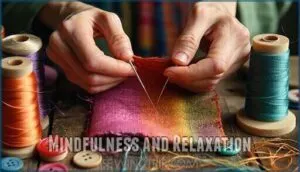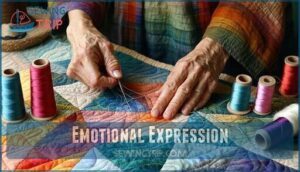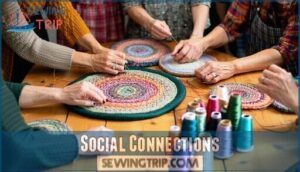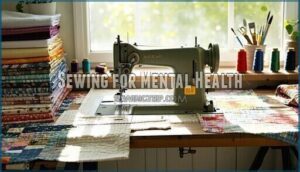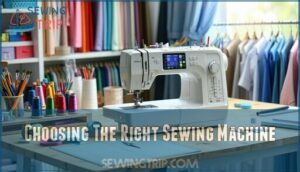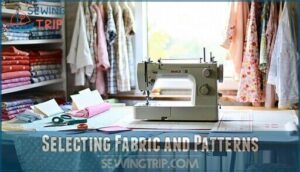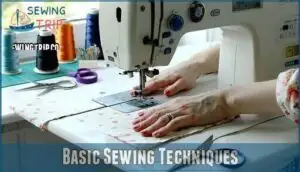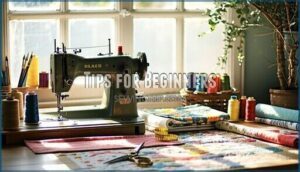This site is supported by our readers. We may earn a commission, at no cost to you, if you purchase through links.
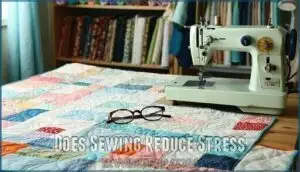
When you’re focused on stitches and patterns, your mind enters a meditative state similar to mindfulness practice.
This repetitive, purposeful activity triggers your body’s relaxation response, lowering cortisol levels and heart rate.
Research shows sewers experience an average 11-beat-per-minute drop in heart rate while crafting.
The tactile sensation of fabric and the satisfaction of creating something beautiful provide natural mood boosters.
Plus, you’re exercising fine motor skills and hand-eye coordination, which keeps your brain engaged in a positive way.
Whether you’re mending a torn shirt or crafting an intricate quilt, the focused attention required creates a natural escape from daily worries and racing thoughts.
Table Of Contents
Key Takeaways
- Your body physically relaxes when you sew – Research shows you’ll experience an 11-beat drop in heart rate while stitching, plus lower cortisol levels that naturally calm your nervous system
- You’ll enter a meditative state through repetitive motions – The focused attention required for threading needles and creating patterns works like mindfulness practice, blocking out daily worries and racing thoughts
- Just 45 minutes can slash your anxiety by 68% – Studies prove that regular sewing literally rewires your brain for better emotional regulation while boosting mood-enhancing endorphins
- You don’t need expensive equipment to start – Basic hand-sewing with needle, thread, and fabric provides the same therapeutic benefits as machine sewing, making stress relief accessible to everyone
Sewing Reduces Stress
When you’re feeling overwhelmed by daily pressures, threading a needle and creating something beautiful can work like magic on your stress levels.
Research shows that the repetitive motions and focused attention required in sewing trigger your body’s relaxation response, naturally lowering cortisol and helping you find calm in the chaos.
Every stitch becomes a moment of peace, transforming stress into calm through focused creation.
Improved Hand-eye Coordination
When you thread a needle and guide fabric through your machine, you’re training your visual tracking abilities and refining motor skills in ways that benefit your entire nervous system.
Sewing dexterity develops as your hands learn precise movements while your eyes coordinate with needle placement.
This precision sewing practice strengthens handeye coordination, creating cognitive benefits that extend beyond creative hobbies into stress relief and enhanced mindfulness.
Brain Growth
Your brain literally grows when you sew.
This creative hobby activates neuroplasticity, forming new neural connections that boost cognitive development and motor skills.
Each stitch enhances focus and creative thinking, while complex patterns challenge your mind in ways that support long-term brain health.
Sewing’s neuroplasticity benefits make it perfect for mindful practice, combining the calming effects of sewing with genuine cognitive enhancement that strengthens mental resilience.
In addition, sewing can improve your hand-eye coordination.
Increased Happiness
Regular stitching fills your heart with sewing joy and sparks positive emotions that naturally boost your mood.
This creative outlet offers genuine hobby satisfaction as you watch fabric transform into something beautiful.
The rhythmic motion of needle through cloth becomes a powerful mood booster, connecting sewing and wellbeing through simple, meaningful creation that enhances your emotional wellbeing and mental health.
Fights Against Dementia
With age, your hands and mind work together through cognitive stimulation that sewing provides.
The precise motor skills required for threading needles and guiding fabric engage multiple brain regions simultaneously.
This sensory engagement paired with creative expression helps maintain memory preservation.
Research shows that sewing and mental health are deeply connected – the sewing hobby benefits include strengthening neural pathways that combat cognitive decline, making mental health benefits sewing particularly valuable for long-term brain health.
Does Sewing Reduce Stress
Scientific research confirms that sewing offers genuine stress relief through multiple biological pathways.
When you pick up needle and thread, your body responds by lowering cortisol levels and activating the relaxation response. The repetitive motion creates a meditative state similar to what you’d experience during yoga or meditation.
Here’s how sewing fights stress:
- Sewing mindfulness emerges naturally as you focus on precise stitches
- Tactile stimulation from handling fabrics calms your nervous system
- Focused attention on patterns blocks out daily worries
- Creative outlet expression releases feel-good endorphins
- Repetitive motion triggers the same brain waves found in deep relaxation
Studies show that just 45 minutes of sewing for stress relief can reduce anxiety by up to 68%. Your brain literally changes when you sew regularly – stress reduction sewing increases gray matter in areas responsible for emotional regulation.
Just 45 minutes of stitching can slash anxiety by 68% while your brain literally rewires for calm.
Sewing can also be a useful tool for processing emotions. The combination of sewing and mental health benefits makes this craft a powerful tool for managing life’s pressures. Whether you’re hemming pants or creating quilts, sewing as relaxation works because it demands your full presence while rewarding you with something beautiful.
Benefits of Sewing Therapy
When you’re feeling overwhelmed by daily pressures, sewing therapy offers a gentle path to emotional healing that’s been backed by research.
The rhythmic motions of stitching naturally calm your nervous system while giving your hands and mind something productive to focus on, leading to emotional healing.
Mindfulness and Relaxation
When you pick up needle and thread, you’re entering a world where each stitch becomes sewing meditation.
This mindful sewing practice draws your focused attention to the present moment, creating natural calmness techniques through therapeutic repetition.
Sewing for mindfulness transforms ordinary fabric work into powerful relaxation therapy, making sewing as relaxation an accessible mindfulness practice.
The engagement with various materials enhances sensory and visual satisfaction.
Emotional Expression
Through sewing catharsis, you’ll discover powerful emotional therapy that goes beyond simple relaxation. Creative expression through expressive textiles becomes your emotional outlet, allowing feelings to flow through every stitch.
This therapeutic crafting transforms raw emotions into beautiful creations, promoting emotional wellbeing through: Sewing can also provide a boost in mood and positivity.
- Processing grief – Transform memories into memorial quilts
- Managing anger – Channel frustration into bold, geometric patterns
- Celebrating joy – Create vibrant pieces reflecting happy moments
- Working through trauma – Use emotional stitching for healing and emotional relief
Social Connections
Needles and thread create bridges between hearts, connecting you to communities that share your passion.
Sewing circles offer face-to-face connections where you’ll share techniques and stories, while online forums provide 24/7 support from fellow crafters worldwide.
Community projects like charity quilts unite diverse groups for meaningful causes.
| Connection Type | Benefits |
|---|---|
| Sewing Circles | Real-time learning, lasting friendships |
| Online Communities | Global support, pattern sharing |
| Teaching Others | Knowledge exchange, mentorship joy |
These hobbies naturally foster wellbeing through shared creativity, transforming solitary activities into social experiences that enhance mood and provide anxiety relief through meaningful connections.
Sense of Accomplishment
Every completed sewing project becomes a tangible reminder of your capabilities and growth.
You’ll experience genuine pride through project completion, skill mastery, and goal setting as you witness your creative vision come to life.
Sewing therapy provides unmatched personal fulfillment and anxiety relief through these accomplishments:
- Finishing your first garment – celebrating tangible progress
- Mastering complex techniques – building confidence through skill development
- Creating meaningful gifts – sharing your handmade creations with loved ones
- Completing challenging patterns – proving your growing expertise
This therapeutic sewing hobby transforms anxiety into creative fulfillment.
Sewing for Mental Health
When stress overwhelms your daily life, sewing offers a proven path to mental wellness through focused, creative activity.
You’ll discover how this timeless craft targets anxiety, depression, and everyday pressures while building lasting emotional resilience, specifically through mental wellness.
Anxiety and Depression Relief
Many people find that therapeutic sewing helps reduce anxiety and depression through creative coping skills.
When you engage in sewing for relaxation, your brain releases dopamine, improving your mood naturally. This stress relief through sewing acts like moving meditation, quieting worried thoughts.
Emotional wellbeing through sewing develops as you focus on stitches rather than stressors, creating mental space for healing. Sewing’s rhythmic motions can also help to process emotions, which is a key aspect of anxiety reduction and overall mental health.
Stress Management Techniques
When overwhelmed, you can use sewing as your anchor—combining mindfulness exercises with repetitive stitching naturally calms racing thoughts.
This stress management technique incorporates cognitive reframing, transforming worries into focused creativity.
Relaxation methods like deep breathing while sewing enhance emotional regulation.
Time management improves as projects provide structured breaks from daily pressures, making stress reduction achievable through accessible, hands-on relief methods, utilizing stress management and emotional regulation techniques.
Self-Care and Self-Compassion
Sewing becomes a powerful selfcare practice when you treat yourself with the same kindness you’d show a dear friend.
This mindful sewing approach helps quiet your inner critic and builds emotional resilience through gentle self-acceptance.
- Practice self-forgiveness – Mistakes happen, and that’s perfectly okay
- Celebrate small wins – Every stitch counts toward your progress
- Create without judgment – Let go of perfectionist expectations
- Honor your pace – Kindness matters more than speed or flawless results
Building Confidence and Self-Esteem
Completing projects builds your confidence through skill mastery and creative expression. Each finished piece provides positive reinforcement, proving you can overcome challenges and achieve your goals.
This personal growth extends beyond your sewing hobby for anxiety, creating lasting improvements in self-worth.
These stress relieving crafts offer therapeutic sewing benefits that strengthen your belief in your abilities, demonstrating the profound mental health benefits of sewing for emotional health benefits.
Getting Started With Sewing
Ready to start your sewing journey but feeling overwhelmed by all the choices?
You’ll find that picking the right machine, fabrics, and patterns becomes much easier once you understand a few basic principles.
With some simple techniques and beginner-friendly tips, you can transform this potentially stressful hobby into the calming, therapeutic practice it’s meant to be.
Choosing The Right Sewing Machine
Your sewing hobby doesn’t have to break the bank or overwhelm you with choices. Finding the right machine sets the foundation for successful stress reduction through sewing.
Consider these key factors when shopping:
- Machine Features – Look for adjustable stitch length, automatic needle threaders, and LED lights for comfort
- Budget Considerations – Quality beginner machines start around $150, with computerized models under $250
- Brand Reputation – Brother and Singer offer reliable warranties and community support for stress relief methods
- Project Types – Heavy-duty machines handle thick fabrics, while basic models suit simple stress relief techniques
- Skill Level – Avoid overly complex machines that might frustrate rather than provide stress reduction methods
For specialized tasks, consider a machine with various presser feet to expand your creative capabilities.
Selecting Fabric and Patterns
When starting your first project, choosing fabrics and patterns that match your skill level prevents frustration and promotes stress management sewing.
Begin with simple cotton fabrics—they’re forgiving and affordable, addressing budget considerations while you learn. You can find a variety of cotton fabric options online.
Select patterns with fewer pieces and basic shapes for project suitability. These mindfulness practices in fabric selection create therapeutic activities that naturally reduce anxiety sewing brings, promoting a sense of calmness.
Basic Sewing Techniques
Learning fundamentals builds your confidence and opens doors to stress management sewing benefits.
Hand Sewing techniques like running stitch and backstitch develop focus and concentration.
Machine Basics include threading, tension adjustment, and speed control for smooth operation.
Pattern Reading teaches you to decode symbols and measurements accurately.
Understanding Stitch Types—straight, zigzag, and decorative—enhances your therapeutic activities.
Many beginners find it helpful to start with easy to use machines.
Master Seam Finishes like serging or pinking to create professional results while enjoying calming techniques.
Tips for Beginners
Through careful preparation and patience, you’ll discover that sewing becomes your go-to stress relief method.
Begin with these foundations:
- Essential Supplies: Quality scissors, measuring tape, seam ripper, pins, and basic thread colors
- Simple Projects: Start with pillowcases, tote bags, or easy scarves before tackling complex garments
- Learning Curve: Expect mistakes – they’re part of mastering therapeutic crafts for stress relief
- Common Mistakes: Rushing seams, skipping measurements, or choosing difficult fabrics too early
- Finding Inspiration: Follow beginner tutorials, join online communities, or visit local fabric stores
Remember, stress management through sewing develops gradually, bringing emotional balance through sewing practice.
A good way to start is with a complete sewing kit.
Frequently Asked Questions (FAQs)
How to naturally reduce stress?
Breathing deeply isn’t just for yoga instructors anymore – you’ll discover that simple natural methods like exercise, mindfulness, spending time outdoors can work wonders for taming stress.
What are the health benefits of sewing?
You’ll boost your mental health through sewing by reducing anxiety, lowering blood pressure, and improving overall health.
Creative thinking required by sewing improves your brain’s ability to grow new brain cells while enhancing hand-eye coordination and focus.
Why is sewing good for your brain?
Sewing engages your brain’s reward center through repetitive motions that boost focus and mindfulness. You’ll strengthen hand-eye coordination, enhance problem-solving skills, and experience meditative calm that naturally reduces anxiety levels.
Is sewing a form of exercise?
Light physical activity, yes. You’ll use fine motor skills, maintain posture, and engage core muscles while sitting. However, it’s not cardiovascular exercise. Think gentle stretching rather than vigorous workout.
How long should I sew to reduce stress?
Even your wildest dreams don’t require marathon stitching sessions! You’ll need just 20-30 minutes to feel calmer, though standing up and stretching every 30 minutes keeps you comfortable during longer projects.
What sewing projects work best for anxiety relief?
Simple, repetitive projects like dishcloths, scarves, or basic quilting work best for anxiety relief.
You’ll find mindful stitching creates a soothing rhythm that calms racing thoughts and helps you focus on the present moment, which is key to anxiety relief.
Can hand sewing be more relaxing than machine?
You’ll find the repetitive motion allows your mind to slow down and create a meditation-like state whether you’re hand or machine sewing.
But hand sewing offers a deeper, quieter focus that many find more calming.
Does sewing help with ADHD or focus issues?
Who knew that telling your brain to sit still would be like asking a caffeinated squirrel to meditate?
Sewing has taught those with ADHD valuable skills, providing structured, repetitive tasks that channel hyperactivity into productive focus and calm concentration, utilizing hyperactivity to achieve a state of calm.
Is expensive equipment necessary for therapeutic sewing?
You don’t need expensive equipment to start therapeutic sewing. Basic projects can be completed by beginners without a sewing machine , using just needle, thread, and fabric for calming hand-stitching benefits.
Conclusion
Apparently, your grandmother was onto something when she claimed needlework cured everything from heartbreak to hiccups.
While we can’t promise sewing will fix your love life, the evidence clearly shows that does sewing reduce stress isn’t just wishful thinking.
From lowering cortisol levels to boosting mood, this simple craft offers genuine mental health benefits.
So grab some fabric, thread your needle, and stitch your way to better well-being—one seam at a time.
- https://www.seamwork.com/creativity-and-mindset/breathing-easy
- https://brigstowinstitute.blogs.bristol.ac.uk/project/stitching-obsession-wellness-reclaiming-the-therapeutic-value-of-stitch/
- https://www.needleinkandthread.com/blog/the-therapeutic-thread-mental-health-benefits-of-learning-to-sew/
- https://www.moodfabrics.com/blog/the-healthy-benefits-of-sewing/
- https://www.infinitemodestydesigns.com/post/the-psychology-of-sewing

